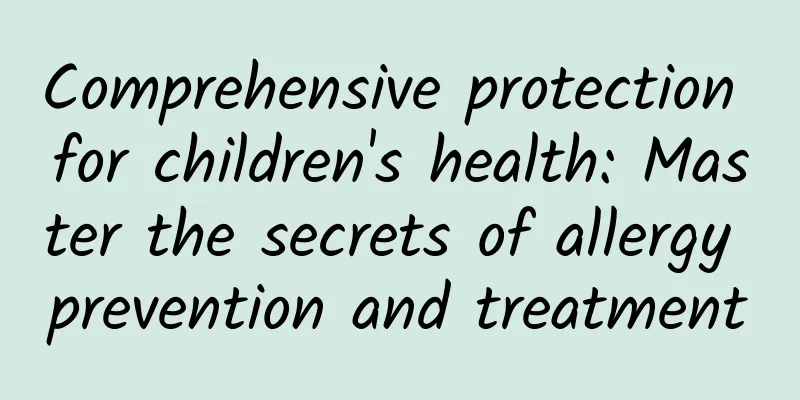Comprehensive protection for children's health: Master the secrets of allergy prevention and treatment

|
Author: Yu Xingmei Children's Hospital Affiliated to Suzhou University Reviewer: Hao Chuangli, Chief Physician, Children's Hospital Affiliated to Soochow University "My baby has a rash again," "My baby is allergic to milk and eggs," "My child has rhinitis, which breaks out in the spring!" "My child has asthma, which is also allergic." There are thousands of allergies, which one will your baby be prone to? Figure 1 Copyright image, no permission to reprint Worldwide, the incidence of allergic diseases is showing a clear upward trend, and allergic diseases seem to have become an "epidemic". Many mothers are anxious and confused. Allergies not only affect children's daily lives, but also harm their physical and mental health. Allergic diseases include food allergies, atopic dermatitis, allergic rhinitis and allergic asthma. The World Allergy Organization has designated July 8 of each year as World Allergy Day to enhance the public's awareness of allergic diseases. So, what are the secrets to preventing and treating allergies? 1. What are allergic diseases? Allergic diseases are a group of diseases caused by the body's immune system's hypersensitivity to typical harmless substances in the environment, including allergic rhinitis, atopic dermatitis, allergic asthma, food allergies and severe allergic reactions. The manifestations of allergic diseases in children at different stages are different. In infancy, it usually manifests as eczema or food allergies. The above symptoms will improve on their own around the age of 3, but respiratory allergic diseases will gradually appear, manifested as rhinitis and asthma. This process is the natural progression of allergic diseases. 2. How to identify whether you have allergic asthma/rhinitis 1. When children often cough and wheeze when they wake up in the early morning or when seasons change, you should suspect that they have asthma. 2. If your child often experiences unexplained nasal itching and stuffiness, followed by continuous sneezing and clear nasal discharge when waking up in the morning, you should be alert to whether he or she has allergic rhinitis. If you suspect your child has asthma or allergic rhinitis, you should consult a specialist. The doctor will ask about your child's condition and make a diagnosis after conducting relevant tests. Figure 2 Copyright image, no permission to reprint 3. What are the common allergens in life? 1. Inhaled allergens such as pollen, catkins, dust, insect mites, cold air, animal dander, oil smoke, various spices, etc. 2. Food allergens such as seafood, fish, shrimp, dairy products, soy products, flour, wheat, nuts, dried fruits, etc. 3. Contact allergens such as cosmetics, hair dyes, paints, cold air, hot air, ultraviolet rays, radiation, bacteria, mold, viruses, parasites, etc. 4. Other types of allergens, such as injectable drugs such as penicillin, streptomycin, xenobiotic serum, etc. 4. How to avoid dust mites Dust mites have become one of the main harmful organisms in life and are the main culprits for asthma, rhinitis and many skin diseases. According to statistics, asthma patients caused by dust mites account for 70% to 80% of the total number of allergy patients. Dust mites are a type of harmful arthropod that is hard to see with the naked eye. They mainly feed on skin flakes. Dust mites can be found wherever people live. These small creatures can get into almost any place, especially beds, corners in the house, carpets, and bedding. "There are often more than 2 million mites living in our beds, and 4,000 of them can be killed by stepping on them." The allergenicity of dust mites has been recognized both at home and abroad. Whether it is live mites, dead mites, or dust mite feces balls, they are very strong allergens. They fly into the air when making beds, folding quilts, and sweeping the floor, and when inhaled by people with allergies, they trigger allergic reactions. Measures to avoid indoor allergens such as dust mites: ① Keep the room ventilated; ② Reduce the use of plush toys and synthetic blankets; ③ Bedding: soak and rinse in 55-60 ℃ water, expose to the sun for 5-6 hours and pat; ④ Use anti-mite bedding. Figure 3 Copyright image, no permission to reprint Life tips : Allergies are no small matter. Prevention is the key to allergies. After identifying the allergens, we should effectively reduce the concentration of allergens in the environment and avoid allergies as much as possible. If an allergic reaction occurs, don't panic, respond rationally, seek medical treatment as soon as possible, and receive standardized treatment. References Editorial Board of Chinese Journal of Pediatrics, Chinese Medical Association Pediatrics Branch. Expert consensus on diagnosis and treatment of allergic diseases in children[J]. Chinese Journal of Pediatrics, 2019, 57(3): 164-171. |
<<: The latest research: Gaining weight really makes people stupid!
>>: Can athlete's foot be cured by walking in the dirt? Not recommended!
Recommend
Can I remove moles while pregnant?
Everyone loves beauty, and everyone wants to make...
Best recipes for menstruation
Women must pay special attention to their diet du...
How to withdraw Douyin red envelope income to Alipay? Can I withdraw it directly to WeChat? Attached tutorial diagram
Tik Tok short videos are really popular now. Many...
What should I pay attention to when inducing labor at 5 months?
Many female friends need to have induced labor af...
Delayed menstruation and increased appetite
Menstruation is an important physiological cycle ...
The woman responded that she would not refuse
What's the first thing your girlfriend does e...
Is it normal for an 18-year-old girl to feel tired and chest tightness?
An 18-year-old girl is in the prime of her life, ...
How to prevent intestinal cancer? What are the symptoms of intestinal cancer?
Regular bowel movements can help us expel toxins ...
What are the symptoms of prolactin pituitary tumor
I believe that many friends sometimes feel unwell...
There are red blood streaks in the vaginal discharge
Leucorrhea can also reflect the health of a woman...
How to tell if the beaten eggs are bad? Can ordinary eggs be made into runny eggs?
The yolk of an egg is rich in sterols, lecithin, ...
Brown discharge during pregnancy
If a blood test confirms pregnancy and brown disc...
What are the symptoms of qi deficiency and blood stasis in women
Women are very prone to qi deficiency and blood s...
Can patients with thyroid disease still eat iodized salt?
□ Science Times reporter Shi Qi May 15th is the 3...
Difference between lobular hyperplasia and nodules
Breast hyperplasia can be regarded as one of the ...









